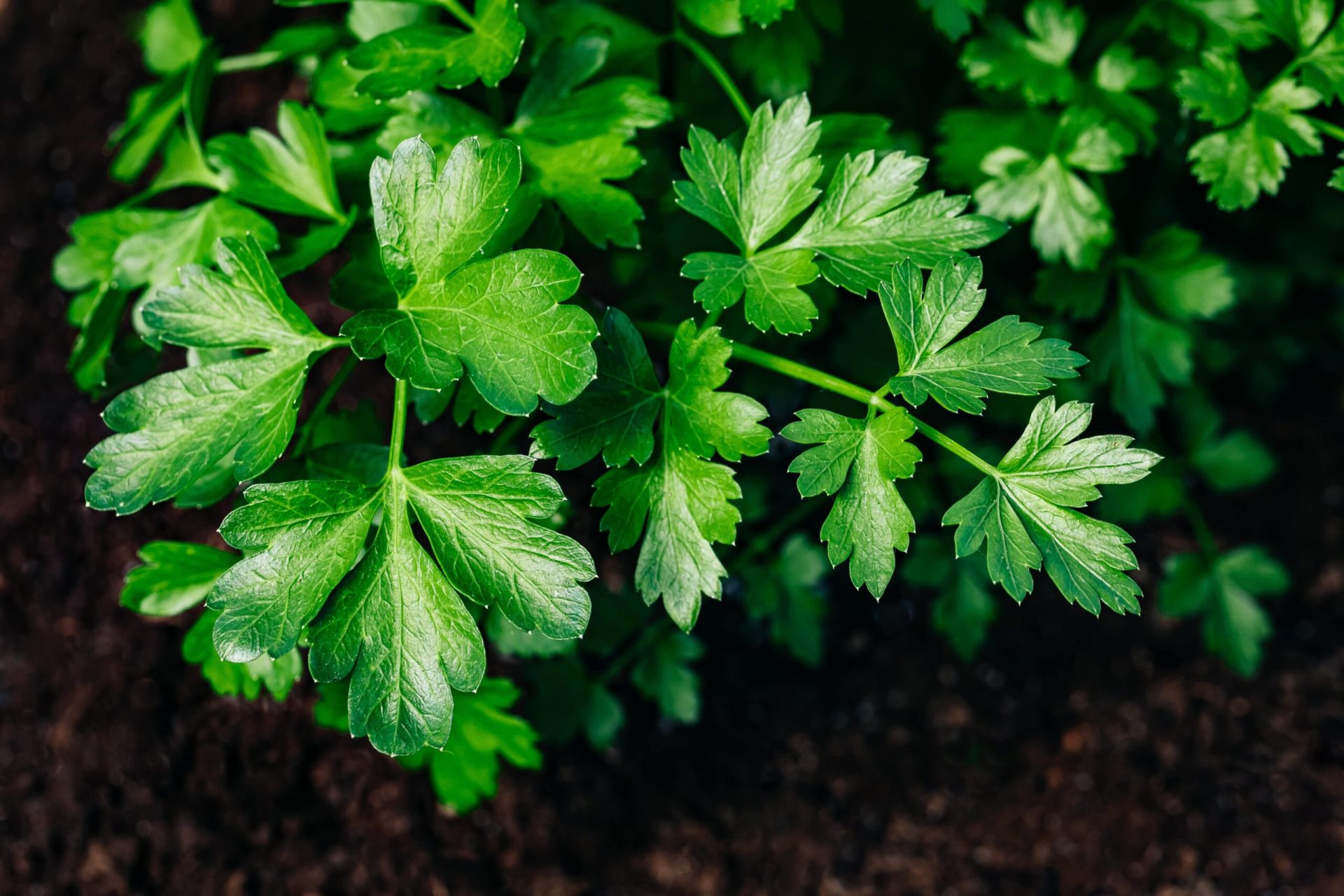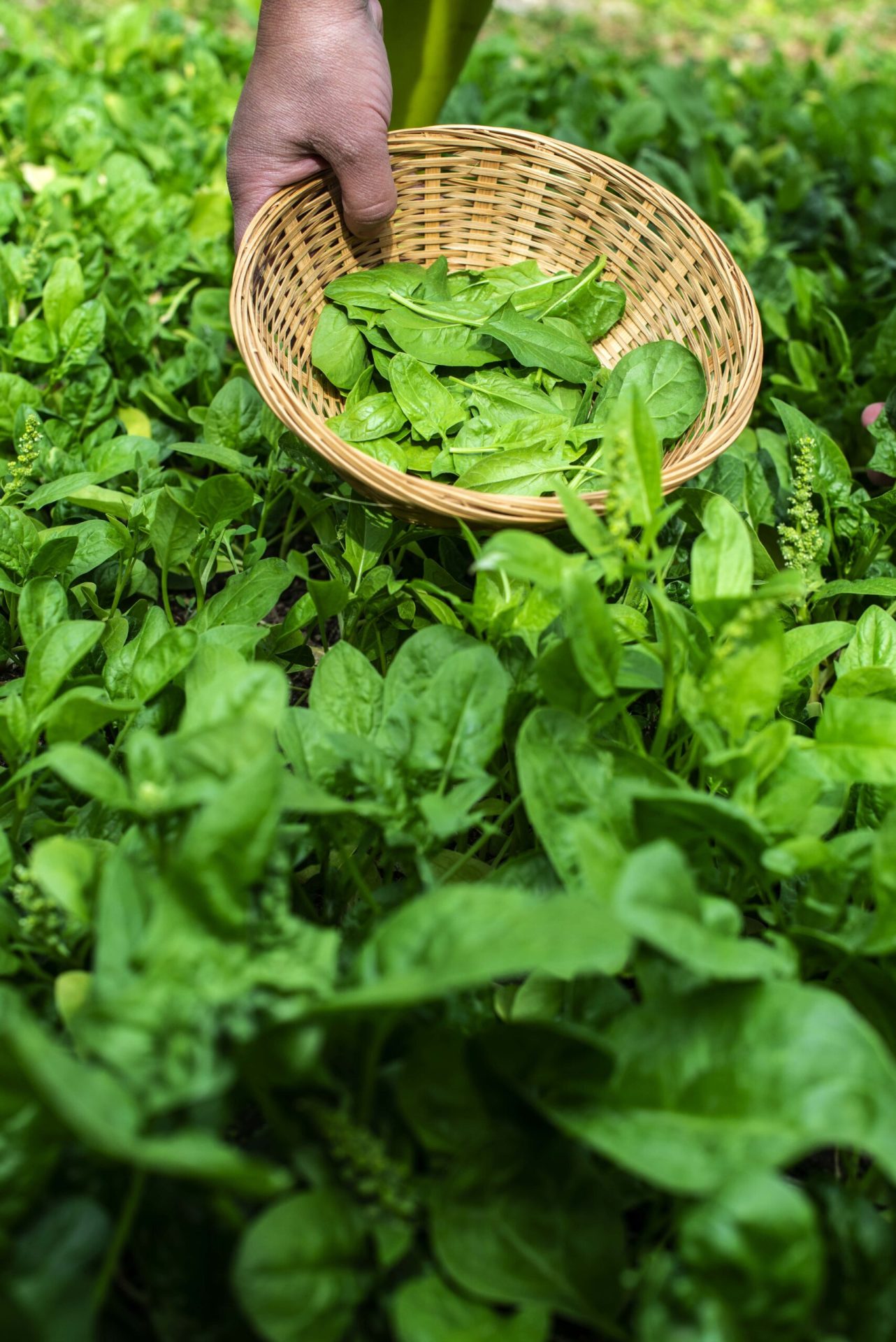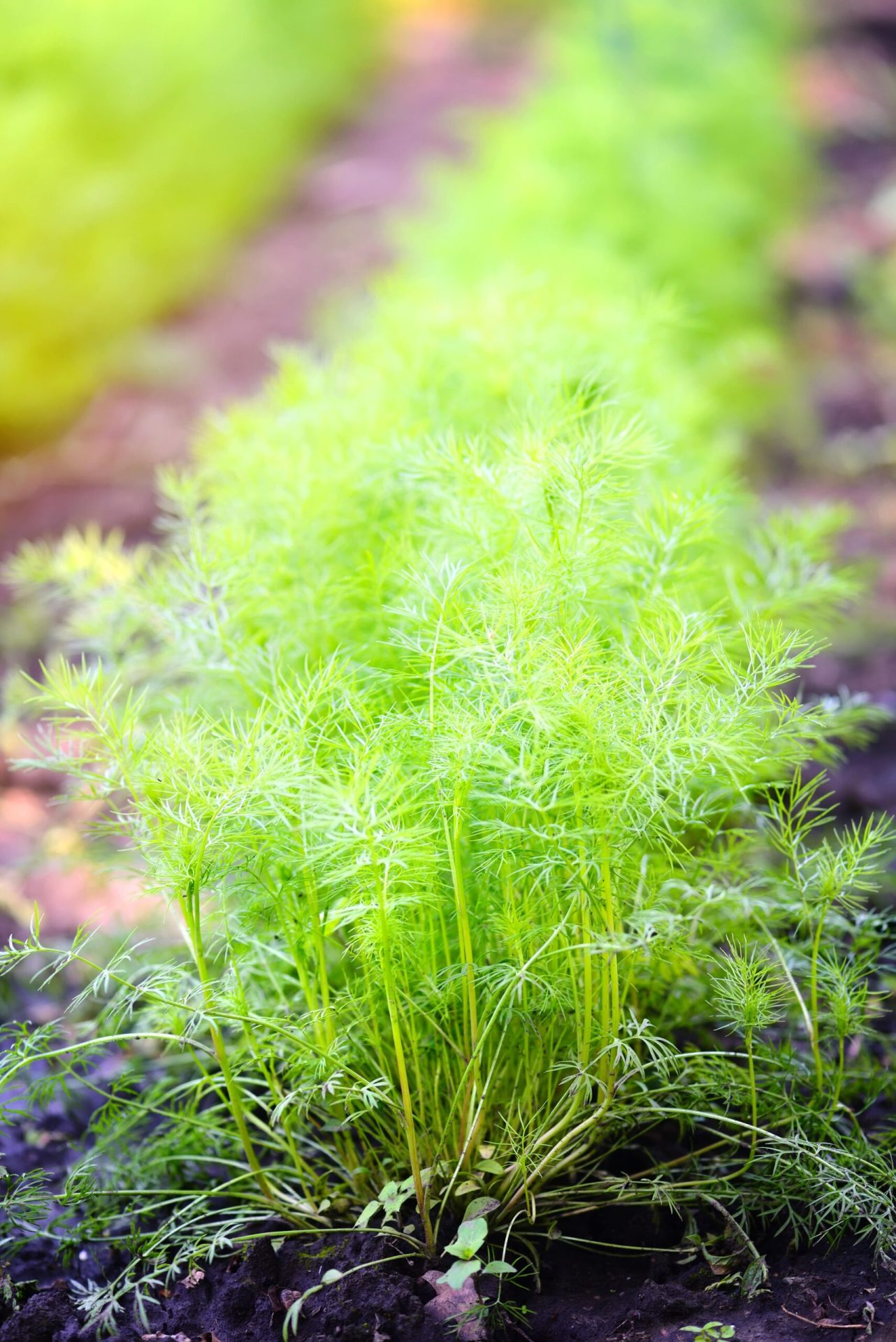Parsley is a biennial plant that has bright green and feather-like leaves. People use this popular herb in dried or fresh form or for garnishing foods like soups, salads, stir-fries, and stews. In this growing guide, we will walk you through everything you need to know to cultivate parsley in your garden.
Learn how to grow parsley in your home garden, from seed to harvest. We will cover everything from growing parsley in containers, to parsley growing stages, different varieties, storage, and companion plants.
Growing Parsley 101: Step-by-Step Guide
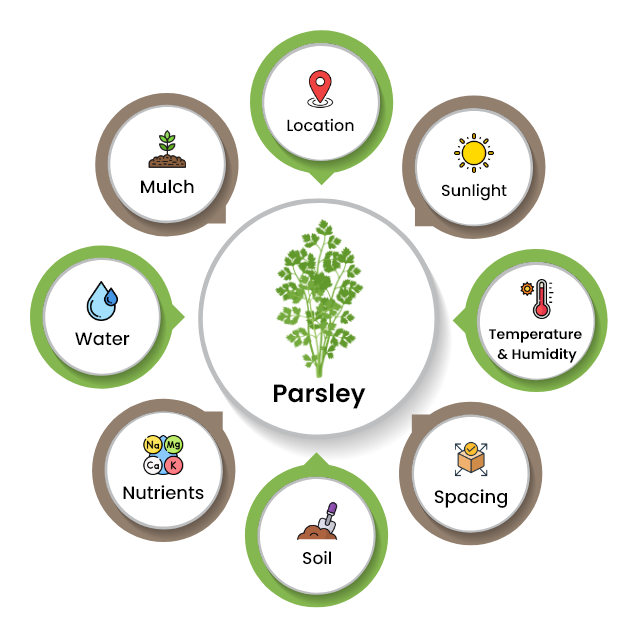
1. Location
Locate a sunny spot that receives direct sunlight for 6-8 hours daily.
2. Temperature and Humidity
Parsley grows well in temperatures ranging between 60-65°F. The humidity requirement for parsley is between 40%-70%.
3. Spacing
Space parsley plants about 6-8 inches apart.
4. Soil
Well-drained soil rich in organic matter are perfect for growing parsley. Also, the soil should have a pH of 5.5-6.7.
5. Nutrients
Use a 5-10-5 commercial fertilizer. Use it at a rate of three ounces per 10 feet of row to grow parsley.
6. Water
Parsley requires watering 2-3 times a week.
7. Mulch
A light mulch comprising grass clippings and ground-up leaves help retain moisture and keep weeds to a minimum.
How to Grow Parsley from Seeds?
Growing parsley from seeds can be frustrating for beginners at the initial stage. But once you know a few tricks, you will succeed in it.
- Soaking seeds overnight before planting will help to speed up the germination process.
- Either sow parsley seeds indoors, plant them once frost has passed, or start outside when the weather gets warm.
- To sow parsley seeds, sprinkle the seeds onto the soil.
- Cover it with a thin layer of soil over the top and moist it with water.
- Keep the soil moist but not wet or dry through the germination stage.
- Seeds germinate in about 14-28 days at a soil temperature of 10-30°C.
- Allow seedlings to grow about 5-7 cm before transplanting.
- Once they have developed their first set of true leaves, transplant seedlings large enough to handle in the garden.
- Space plants 30-40 cm apart with rows 30 cm apart.
- Harvest when leaves are dark green and flowering stems extend the harvest window.
How to Grow Parsley in Containers?
- You will require a container which is at least 8 inches deep.
- Ensure that parsley is getting enough of the essential nutrients.
- To grow bushy green leaves, use a water-soluble fertilizer every few weeks to provide the necessary nitrogen.
- Fill the container with humus and loamy soil, which is slightly acidic and has a neutral pH of 6.0-7.0.
- Amend it with moisture-retentive materials like peat moss, coconut coir, etc.
- Sow seeds 1-2 inches apart, about ¼ inch deep.
- Keep the soil moist, but don’t water deeply.
- Feed it with a balanced fertilizer, like 10-10-10 NPK.
How to Transplant Parsley Seedlings?
You should transplant seedlings after the plant has established itself.
- Choose a location with appropriate space for the parsley plant to grow to its mature size.
- Dig a hole that should be twice the diameter of the plant’s root ball.
- With a trowel or shovel, the hole should be as deep as the root ball’s height.
- Loosen the soil from the bottom and the sides of the hole for easy plant root penetration.
- Inspect the roots. Trim any damaged or tangled roots to encourage healthy growth.
- Untangle any roots growing in a circle with your fingers. Place the root ball in the hole.
- Position the parsley plant in the prepared hole.
- The top of the root ball should be in level with the soil.
- Adjust the depth of the hole if required.
- Fill the hole half with the soil and water to let the soil settle.
- Complete filling the hole with soil and firming it around the plant.
- Water the plant thoroughly. Provide stakes or support to maintain the plant’s stability and encourage upright growth if required.
When to Plant Parsley?
The best time of the year to grow parsley is from early spring to early summer. Harvesting time for parsley would be throughout summer and autumn.
How to Plant Parsley Seeds?
- Sow parsley seeds thinly about ½ inch deep in the soil.
- Cover it with soil and water it gently.
- Space rows 6 inches apart.
- Germination can take up to six weeks.
Parsley Growing Stages

1. Seed Germination
Parsley seeds take around 2-4 weeks under optimal conditions. At this stage, the seeds absorb moisture and nutrients from the soil. They swell and eventually sprout into seedlings.
2. Seedling
After germination, parsley seedlings emerge from the soil with their first set of true leaves. During this stage, seedlings are delicate and vulnerable to environmental stressors. They require careful attention to watering and protection from pests and diseases.
3. Vegetative growth
As the parsley plants grow, they develop an additional set of leaves and establish a more robust system. The leaves gradually increase in size and build parsley’s characteristic shape and texture. They have serrated or deeply lobed edges, based on the variety.
4. Bolting (Flowering)
In the second year of growth, parsley enters the bolting stage, especially in regions with mild winters. Bolting occurs due to changes in temperature and day length. It causes the plant to produce a tall, upright flower stalk topped with small clusters of yellow-green flowers. Once parsley bolts, its flavor becomes bitter, and leaves lose their culinary appeal.
5. Maturity
Parsley matures by developing a complete and bushy growth habit and producing abundant, flavorful leaves. Based on its growing conditions and variety, maturity occurs within 70-90 days after planting. Harvest its leaves for culinary use. Leave the central growth point intact to encourage continued leaf production.
6. Harvesting
Harvest parsley leaves once they reach a usable size when the plants mature. Use pruning shears or scissors to cut the outer leaves. Leave the inner growth to continue the development of leaves. Regularly harvesting parsley promotes new growth and prolongs the harvest period.
How to Harvest Parsley?
- Start with the lower leaves from the outside of the plant.
- Cut all the way at the plant’s base to include the stem.
- This will stimulate more growth from the center of the plant.
- You should not harvest more than 1/3rd of the plant at a time.
- For this reason, experts suggest growing several plants.
- In this way, you will never have to harvest too much from a single plant.
How to Store Parsley?
Learning about methods to store parsley will help you make the most of this popular herb. Let us know how to store parsley in different ways.
a. Store on Countertop
- Rinse parsley and trim about ½ inch of the bottom portion of the stalks.
- Ensure no leaves are on the bottom 5 inches or so of the stalks.
- Fill a glass or jar with around 4 inches of water and place the parsley bouquet inside.
- Snip off the bottom of the stems.
- Ensure the leaves are thoroughly dry.
- Hold off rinsing them until you are ready to use them.
- Fill a water glass or jar with water.
- Place the stems of the parsley of the herbs into the water in the jar.
- To store herbs in the refrigerator, cover them loosely with a plastic bag.
- It will keep the leaves from losing moisture and prevent them from turning brown.
- You can store parsley either in the refrigerator or at room temperature.
- Change the water after several days if it starts becoming discolored.
- Fresh parsley can last up to 2 weeks or longer when stored in this way.
b. Store in Refrigerator
- Wash and dry parsley leaves in the refrigerator.
- Ensure leaves are thoroughly dry before storing them. Otherwise, they might get spoiled.
- Wrap stalks properly in a wet paper towel.
- Place the parsley in an airtight container or a zip-close bag.
- If you notice the paper towel getting dry, sprinkle it with water.
- It will keep your parsley fresh for about 7-10 days.
c. Store in Freezer
- Rinse and dry your parsley.
- Chop the parsley leaves into small pieces or leave them as a whole.
- Place in ice cube tray compartments and fill each with olive oil or butter, based on your preference and intended use.
- Place this tray in the freezer.
- Remove the frozen cubes from the trays.
- Store them in the freezer container.
- Leave them in the trays and pop them out whenever required.
Best Parsley Varieties
1. Curly Parsley
This parsley variety is versatile and easy to grow. It has curly and ruffled leaves, hence its name. Its leaves are smooth, shiny green, and divided into pairs on ribbed stems.
It has a pleasant taste, so people use it to enhance the flavor of stews, soups, and other cuisines. It is used for garnishing. You can use it fresh, dried, or frozen.
2. Italian Parsley
The parsley variety has triangular, flat leaves with deep teeth. The leaves grow in clusters of three on slender branches. These branches connect to a central stem.
It has a strong aroma and flavor, which is slightly less bitter. This delicate herb has hints of citrus, nutmeg, and clove, which have earthy tastes.
3. Moss Curled Parsley
The dark green leaves curl thickly, resembling moss, hence the name. It has a strong peppery taste. People use it fresh or dried in soups, salads, and sauces, to make a decorative garnish.
Common Pests and Diseases Problems with Parsley
Pests that can affect the growth of parsley plants are aphids and caterpillars. Diseases like whiteflies, fungal diseases, leaf blight, parsley fungus, and viral diseases impact the development of parsley.
Keep parsley plants healthy by following preventive measures and promptly addressing any issues.
Companion Plants for Parsley
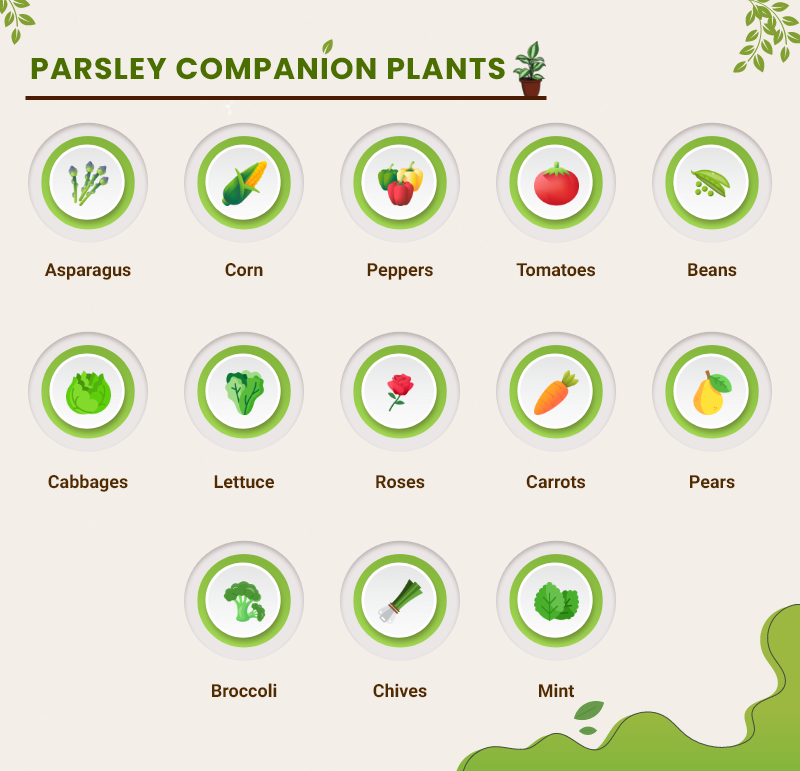
Companion plants for parsley can prove beneficial or backfire, so it is essential to choose plants wisely. Some plants are good for growing leafy greens. These include asparagus, tomatoes, peppers, corn, chives, basil, beans, brassicas, roses, apples, and pears.
Planting companion plants around parsley can help protect it from pests and diseases. It can improve flavor, soil health, production, and space utilization. Companion plants provide shade and shelter to parsley plants. They act as a living mulch or windbreak for fragile crops.

